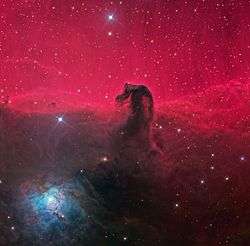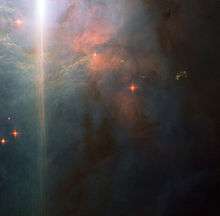NGC 2023
| Reflection nebula | |
|---|---|
| emission nebula | |
 NGC 2023 next to the Horsehead nebula | |
| Observation data: J2000 epoch | |
| Right ascension | 05h 41m 37.9s[1] |
| Declination | −02° 15′ 52″[1] |
| Distance | 1467.7 ly (450 pc) |
| Apparent dimensions (V) | 10'×10'[2] |
| Constellation | Orion[2] |
| Designations | NGC 2023,[2] LBN 954,[1] VDB 52, [XT95] 6, GN 05.39.1.02, RAFGL 806, [NYS99] C-23, IRAS 05391-0217, RX J0541.8-0217, [RK68] 38 |
NGC 2023 (also known as LBN 954[1]) is an emission and reflection nebula located in the constellation of Orion. It was discovered by William Herschel on 6 January 1785. Its size in the night sky is 10 × 10 arcminutes.[2] At a distance of 1467 light-years (450 parsecs) from Earth, it is located close to the Orion Nebula.[3][4]
The region emits fluorescent molecular hydrogen emission at near-infrared range.[5] It is four light-years in diameter,[4] making it one of the largest reflection nebulae ever discovered. It is illuminated by the B1.5 star HD 37903, the most luminous member of the stars in the Lynds 1630 molecular cloud.[4]
References
| Wikimedia Commons has media related to NGC 2023. |
- 1 2 3 4 "SIMBAD query result for NGC 2023". SIMBAD Astronomical Database. Retrieved 2 August 2016.
- 1 2 3 4 "NGC Objects: NGC 2000 - 2049".
- ↑ "Sunset glow in Orion". NASA. 25 July 2011.
- 1 2 3 "Astronomy Photo of the Day (APotD): 11/07/14 — NGC 2023". 7 November 2014. Archived from the original on 2014-11-07. Retrieved 2014-11-07.
- ↑ "Near-IR Fluorescent Molecular Hydrogen Emission from NGC 2023". Publications of the Astronomical Society of Australia. 15 (2): 194–201. Bibcode:1998PASA...15..194B. doi:10.1071/AS98194.
External links
- VizieR – NGC 2023
- NED – NGC 2023
- NGC 2023 on WikiSky: DSS2, SDSS, GALEX, IRAS, Hydrogen α, X-Ray, Astrophoto, Sky Map, Articles and images
Coordinates: ![]()
This article is issued from
Wikipedia.
The text is licensed under Creative Commons - Attribution - Sharealike.
Additional terms may apply for the media files.
